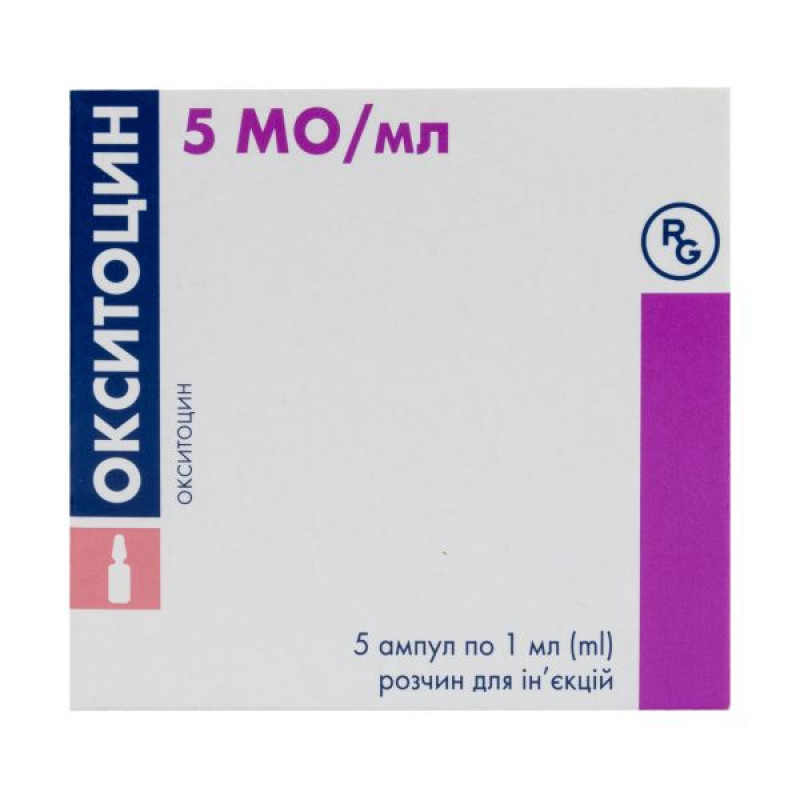Oxytocin solution for injection 5 IU ampoule 1 ml No. 5

Instructions Oxytocin solution for injection 5 IU ampoule 1 ml No. 5
Composition
active ingredient: oxytocin;
1 ml contains 5 IU of oxytocin;
Excipients: glacial acetic acid, chlorobutanol hemihydrate, ethanol (96%), water for injections.
Dosage form
Solution for injection.
Main physicochemical properties: colorless transparent solution.
Pharmacotherapeutic group
Hormones for systemic use, excluding sex hormones, posterior pituitary hormones, oxytocin and its derivatives. ATC code H01B B02.
Pharmacological properties
Pharmacodynamics
The clinical and pharmacological properties of oxytocin are similar to those of endogenous oxytocin from the posterior pituitary. The uterine myometrium contains oxytocin receptors, which belong to the G-protein receptor family. Oxytocin causes contraction of uterine smooth muscle by increasing intracellular calcium concentration and thus induces contractions similar to those in physiological spontaneous labor, and also temporarily reduces uterine blood flow.
With an increase in the amplitude and duration of muscle contractions, the cervix dilates and smoothes. As pregnancy progresses, the number of oxytocin receptors and the sensitivity of the uterus to it increase and reach their maximum by the end of pregnancy. With the introduction of oxytocin in appropriate doses, it is possible to increase the contractile ability of the uterus from a moderate increase in the strength and frequency of spontaneous contractions (typical of physiological labor) to persistent tetanic contractions.
Oxytocin causes contraction of myoepithelial cells surrounding the alveoli of the mammary glands, thereby promoting milk ejection.
By acting on vascular smooth muscle, oxytocin causes vasodilation, increases blood flow in the kidneys, coronary vessels and cerebral vessels. Blood pressure, as a rule, does not change, however, with intravenous (IV) administration of oxytocin in large quantities in the form of an undiluted solution, a temporary decrease in blood pressure may be observed with the development of reflex tachycardia and a reflex increase in cardiac output. Following the decrease in blood pressure, a small but persistent increase occurs.
Unlike vasopressin, oxytocin has minimal antidiuretic effects. However, hyperhydration may occur if oxytocin is administered with large amounts of electrolyte-free fluids and/or if they are administered too rapidly.
Pharmacokinetics
When administered intravenously, the effect of oxytocin on the uterus occurs almost instantly and lasts for 1 hour. After intramuscular administration of the drug, the myotonic effect occurs after 3-7 minutes and lasts for 2-3 hours.
Like vasopressin, oxytocin is distributed in the extracellular space. Small amounts of oxytocin probably enter the fetal circulatory system.
The half-life of oxytocin is from 1 to 6 minutes (less in late pregnancy and during lactation). Most of the drug undergoes rapid metabolism in the liver and kidneys. Oxytocin is inactivated by enzymatic hydrolysis, mainly under the action of tissue oxytocinase. Oxytocinase is also found in placental tissues and blood plasma. Only a small amount of oxytocin is excreted unchanged by the kidneys.
Kidney failure
Studies in patients with renal insufficiency have not been conducted. However, given the route of elimination and the impairment of renal excretion of oxytocin due to antidiuretic action, there is a possibility of accumulation and prolonged action of oxytocin.
Liver failure
Studies in patients with hepatic insufficiency have not been conducted. Changes in the pharmacokinetics of the drug in patients with impaired liver function are unlikely, since the enzyme that metabolizes oxytocin (oxytokinase) is not only located in the liver, and oxytocinase activity in the placenta increases significantly until delivery. Thus, the biotransformation of oxytocin in conditions of impaired liver function will not cause a significant change in the metabolic clearance of oxytocin.
Indication
Oxytocin is used to stimulate and enhance uterine contractions.
Use in the prenatal period
Induction of labor
For the purpose of labor induction, oxytocin is used in late or near term pregnancy in the presence of arterial hypertension (e.g., preeclampsia, eclampsia, or in the presence of cardiovascular and renal disease), fetal erythroblastosis, maternal or gestational diabetes mellitus, antepartum hemorrhage or the need for preterm delivery, premature rupture of membranes, and the impossibility of spontaneous labor. Planned labor induction with oxytocin may be indicated in late pregnancy (more than 42 weeks of gestation), as well as in the case of intrauterine fetal death or intrauterine fetal growth retardation.
Increased uterine contractile activity
In the first or second stage of labor, oxytocin can be administered intravenously as an infusion to enhance uterine contractility during prolonged labor or dysfunctional uterine inertia.
Control of postpartum hemorrhage and uterine hypotension.
Other indications for use
As an adjunctive therapy for incomplete abortion or threatened abortion.
Diagnostic application
Assessment of fetal embryo-placental respiratory reserve in high-risk pregnancies (oxytocin stress test).
Contraindication
The use of oxytocin for injection is contraindicated in the following cases:
clinically narrow pelvis; unfavorable position or presentation of the fetus, which prevents natural childbirth without prior intervention (transverse fetal position); so-called urgent obstetric emergencies, in which the benefit-risk ratio for the fetus or mother requires emergency surgical intervention; development of fetal distress before the onset of labor; prolonged use in the absence of uterine contractility or severe toxemia; hypertensive nature of uterine contractions; hypersensitivity to the active substance or to any of the excipients of the drug (see section "Excipients"); induction of labor or increased uterine contractility in cases where delivery through the natural birth canal is contraindicated (previa or prolapse of the umbilical cord loops, complete placenta previa or presentation of the umbilical cord vessels); severe diseases of the cardiovascular system.
Interaction with other medicinal products and other types of interactions
There have been reports of severe hypertension when oxytocin was administered 3-4 hours after prophylactic administration of vasoconstrictors in conjunction with caudal anesthesia.
Anesthesia with cyclopropane, enflurane, halothane, isoflurane may alter the effects of oxytocin on the cardiovascular system, leading to unexpected results such as hypotension. It is also known that the simultaneous use of oxytocin and cyclopropane anesthesia can cause sinus bradycardia and atrioventricular rhythm.
Oxytocin should be administered with caution to patients taking drugs that may prolong the QTc interval.
It has been shown that prostaglandins enhance the effects of oxytocin, so their simultaneous use is not recommended. Due to the increased contractile activity of the uterus, caution should be exercised when using prostaglandins and oxytocin sequentially.
Concomitant use of oxytocin with other inducers of labor or abortion may lead to uterine hypertonia (increased tone) and uterine rupture or cervical injury, for example, the use of prostaglandins may increase the stimulation of labor and stimulation of the uterine musculature.
Therefore, when using the drug, patients must be strictly monitored:
acid-base balance; frequency, duration and strength of contractions; fetal heart rate; maternal blood pressure and heart rate; uterine tone; balance between fluid intake and output.
Application features
Except in special cases, the use of oxytocin is not recommended in the following situations:
premature birth; borderline degree of clinically narrow pelvis (disproportion between the size of the fetal head and the pelvis of the mother); history of major surgery on the cervix or body of the uterus, including cesarean section; excessive uterine distension; multiple births; invasive cervical cancer;
Oxytocin should not be administered until the fetal head or buttocks are inserted into the pelvis.
It is the responsibility of the physician to identify special cases due to combinations of factors. The potential benefits of oxytocin therapy should be carefully weighed against the risk of rare but serious events such as uterine hypertonicity or tetany.
For the purpose of induction of labor and strengthening of uterine contractility, oxytocin is used exclusively intravenously, in a hospital and under appropriate medical supervision. Each patient receiving oxytocin infusion should be under the constant supervision of a physician experienced in the use of the drug.
To avoid complications during the administration of oxytocin, constant monitoring of the following indicators is necessary:
uterine contractile activity; heart rate of the mother and fetus; blood pressure of the mother.
If uterine hyperactivity occurs, oxytocin administration should be discontinued immediately; uterine contractions induced by oxytocin usually subside shortly after discontinuation of the drug.
When used correctly, oxytocin causes uterine contractions similar to those of normal labor. Excessive stimulation, which occurs when the drug is used incorrectly, is dangerous for both the mother and the fetus.
In the presence of hypersensitivity to oxytocin, the development of hypertonic uterine contractions is possible, despite the correct choice of dose and appropriate medical supervision.
When administering the drug, the likelihood of increased blood loss and the development of afibrinogenemia should be taken into account.
Induction of labor should be avoided in cases of fetal death in utero and/or the presence of meconium in the amniotic fluid, as this may lead to amniotic fluid embolism.
Intravenous bolus administration of oxytocin is contraindicated, as it may cause acute short-term hypotension with the development of hyperemia and reflex tachycardia.
Oxytocin should be used with particular caution in patients suffering from cardiovascular diseases (e.g. hypertrophic cardiomyopathy, valvular disease and/or ischemic heart disease, including coronary artery spasm) and prone to myocardial ischemia, in order to avoid significant changes in blood pressure and heart rate.
Oxytocin should be administered with caution to patients with long QT syndrome or associated symptoms, as well as to patients taking drugs that prolong the QT interval.
Against the background of parenteral administration of the drug to induce labor or enhance uterine contractility in the first and second stages of labor, fatal cases of the woman in labor due to the development of hypersensitivity reactions, subarachnoid hemorrhage and uterine rupture, as well as cases of fetal death from various causes, have been described.
Disseminated intravascular coagulation
In rare cases, pharmacological induction of labor with uterotonic agents, including oxytocin, has been associated with an increased risk of disseminated intravascular coagulation (DIC) in the postpartum period. This risk is directly related to the pharmacological induction and not to the specific agent. The risk is particularly increased in women with additional risk factors for DIC: age >35 years, complicated pregnancy (e.g. gestational diabetes, hypertension, hypothyroidism), gestational age >40 weeks. Oxytocin and alternative agents should be used with caution in such women, and the physician should consider the possibility of DIC.
Hyperhydration
Since oxytocin has a weak antidiuretic effect, prolonged intravenous administration of high doses of the drug in conjunction with the administration of large volumes of fluid (for example, in the treatment of threatened or unsuccessful abortion or postpartum hemorrhage) may cause hyperhydration in combination with hyponatremia. When oxytocin is administered and intravenous fluids are administered, a combined antidiuretic effect is observed, resulting in hypervolemia with subsequent development of the hemodynamic form of acute pulmonary edema without hyponatremia.
To avoid these rare complications, the following safety precautions should be observed when administering high doses of oxytocin for a long period of time: use a solvent containing electrolytes (not dextrose); fluid infusions should be performed in small volumes (when inducing or stimulating labor in late pregnancy, oxytocin is allowed to be administered in concentrations exceeding those recommended); oral fluid intake should be limited; fluid balance should be recorded; laboratory testing of electrolytes is indicated if electrolyte imbalance is suspected.
Oxytocin is contraindicated in patients with a history of hypersensitivity to the drug.
Different routes of oxytocin administration cannot be used simultaneously.
Oxytocin can only be administered by one route (either intravenously or intramuscularly).
Ability to influence reaction speed when driving vehicles or other mechanisms
Oxytocin does not affect the ability to drive vehicles and use machines.
Use during pregnancy or breastfeeding
Pregnancy
In the first trimester of pregnancy, the drug is used only in case of spontaneous or induced abortion; there are no other known indications for use. Given the extensive experience of use, the chemical structure and pharmacological properties of the drug, when prescribed according to indications, an increased risk of fetal malformations is not expected.
Breastfeeding period
Oxytocin is found in small amounts in breast milk.
In cases where the drug is prescribed to stop uterine bleeding, it is not recommended to start breastfeeding until the end of the course of oxytocin treatment.
Method of administration and doses
Dosage
The dose is selected individually, according to the indications and taking into account the reaction of the mother and fetus to the administration of the drug.
For induction or stimulation of labor
For the induction or stimulation of labor, oxytocin is used exclusively as an intravenous drip infusion. Strict adherence to the infusion rate is a prerequisite. To ensure safe induction or stimulation of labor, oxytocin should be administered using an infusion pump or other similar device. In addition, it is necessary to regularly monitor uterine contractility and fetal heart rate. In case of excessive uterine contractility, the oxytocin infusion should be stopped immediately, and a rapid decrease in excessive uterine muscle activity is observed.
Before starting the administration of the drug, you should start the administration of a physiological solution that does not contain oxytocin. To prepare a standard infusion solution, 1 ml (5 IU) of oxytocin and 1000 ml of a non-hydrophilic solvent should be mixed under sterile conditions. The resulting solution should be mixed thoroughly by rotating the vial. As a result, 1 ml of the solution contains 5 mU of oxytocin. For accurate dosing of oxytocin, it is recommended to use an infusion pump or other similar device. The rate of administration of the initial dose should not exceed 0.5-4 mU/min. Every 20-40 minutes it can be increased by 1-2 mU/min until the desired degree of uterine contractility is achieved. After reaching the desired uterine contraction rate (corresponding to normal labor), in the absence of signs of fetal distress and when the cervix is 4-6 cm dilated, the infusion rate can be gradually reduced at a rate similar to its acceleration. In late pregnancy, high-rate infusion requires caution; only in rare cases may a rate of 8-9 mU/min be required. In case of premature labor, a higher infusion rate may be required, which in some cases may exceed 20 mU/min. The fetal heart rate, uterine tone at rest, and the frequency, duration, and strength of uterine contractions should be monitored. In case of uterine hyperactivity or fetal distress, oxytocin administration should be stopped immediately and the woman in labor should be provided with oxygen therapy. The physician should constantly monitor the condition of the woman in labor and the fetus.
Stopping uterine bleeding in the postpartum period
Intravenous drip infusion (drip method): to stop postpartum bleeding, 10-40 units of oxytocin should be mixed with 1000 ml of non-hydrophilic diluent; for the prevention of uterine atony, 20-40 mU/min of oxytocin is usually required. Intramuscular injection: after the placenta is delivered, 5 units of oxytocin can be administered.
Therapy for incomplete or failed abortion
Ten units of oxytocin should be added to 500 ml of saline or a mixture of 5% dextrose and saline; the infusion rate should be 20-40 drops/min.
Diagnosis of uteroplacental insufficiency (stress test with oxytocin)
The initial infusion rate should be 0.5 mU/min. The infusion rate should be doubled every 20 minutes until an effective dose is reached (usually 5-6 mU/min, maximum 20 mU/min). After the appearance of three moderate uterine contractions (40-60 seconds each) within a ten-minute period, the infusion should be stopped and the occurrence of late or variable fetal heart rate decelerations should be monitored.
Method of application
Intravenous drip infusions or intramuscular injections.
Oxytocin can only be administered parenterally (either intravenously or intramuscularly).
Certain categories of patients
Elderly patients
Studies involving elderly patients (over 65 years of age) have not been conducted.
Renal and hepatic failure
Studies in patients with renal or hepatic insufficiency have not been conducted.
Children
Do not use in children.
Overdose
Symptoms of overdose depend mainly on the degree of sensitivity of the uterus to oxytocin and are not associated with the presence of hypersensitivity to the drug. With hyperstimulation, strong (hypertonic) or prolonged (tetanic) contractions occur, or an increase in uterine tone at rest (between two contractions) to 15-20 mm. h. or more, which leads to irregular labor, rupture of the body or cervix, vagina, postpartum bleeding, uteroplacental insufficiency, fetal bradycardia, fetal hypoxia, hypercapnia and death.
As a serious adverse reaction, convulsions may occur in water intoxication, due to the inherent antidiuretic effect of oxytocin, which may occur if large doses (40 to 50 ml/min) are administered for a prolonged period. Treatment of hyperhydration consists of: discontinuation of oxytocin, restriction of fluid intake, use of diuretics, intravenous administration of hypertonic sodium chloride solution, restoration of electrolyte balance, control of convulsions with appropriate doses of barbiturates, and professional care of the comatose patient.
Adverse reactions
Adverse reactions in postpartum women
| Organ system class | Undesirable effects |
| Blood and lymphatic system disorders | factor I deficiency, hypoprothrombinemia, thrombocytopenia |
| On the part of the immune system | anaphylactic reaction, hypersensitivity |
| Metabolic and nutritional disorders | hyperhydration |
| From the heart | arrhythmia, reflex tachycardia, ventricular extrasystole |
| From the vascular system | Arterial hypotension with subsequent development of arterial hypertension |
| Gastrointestinal tract | nausea, vomiting |
| Complications of pregnancy, postpartum and perinatal period | fatal outcome of childbirth, postpartum hemorrhage, uterine hypertonicity |
| Reproductive system and breast disorders | hemorrhages in the pelvic organs, uterine cramps, tetanic uterine contractions | Injuries, poisonings and procedural complications | uterine rupture |
Adverse reactions in the perinatal period
| Organ system class | Undesirable effects |
| From the organs of vision | Retinal hemorrhage in newborns |
| From the heart | arrhythmia, sinus bradycardia, tachycardia, ventricular extrasystole |
| Respiratory, thoracic and mediastinal disorders | asphyxia |
| Complications of pregnancy, postpartum and perinatal period | fetal death due to asphyxia, neonatal jaundice, brain damage |
| Research | low Apgar score 5 minutes after birth |
A randomized, double-blind, controlled trial found that ST-T segment depression on the ECG was observed during cesarean section under spinal anesthesia with intravenous bolus administration of oxytocin at a dose of 10 IU. The data are insufficient to accurately assess the degree of risk, and the reasons for the increased risk are unknown.
Expiration date
3 years.
Storage conditions
Store in the original packaging at 2-8°C.
Keep the medicine out of the reach of children!
Packaging
1 ml in an ampoule, 5 ampoules in a cardboard box.
Vacation category
According to the recipe.
Producer
JSC "Gedeon Richter".
Location of the manufacturer and its business address
H-1103, Budapest, Demrei Street 19-21, Hungary.
There are no reviews for this product.
There are no reviews for this product, be the first to leave your review.
No questions about this product, be the first and ask your question.












